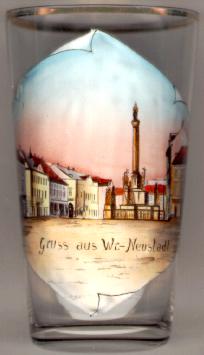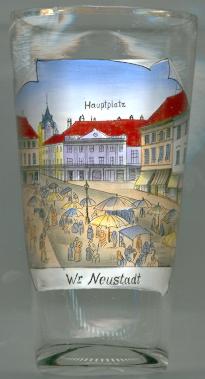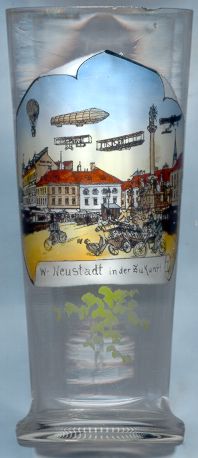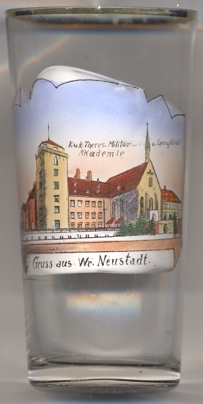

|
| ÖSTERREICH | AUSTRIA |
| Bundesland: Niederösterreich | Lower Austria |
| Stadt: Wiener Neustadt |
 Wiener Neustadt is situated at an elevation of 265 m in the south-east of the Steinfeld plain in Lower Austria,
about 63 km southeast of the Lower Austrian capital, Sankt Pölten and about 45 km
south of Vienna. At a population of 48,500 (2024) it is the second largest city of Lower
Austria and Austria's eleventh most populated city.
Wiener Neustadt is situated at an elevation of 265 m in the south-east of the Steinfeld plain in Lower Austria,
about 63 km southeast of the Lower Austrian capital, Sankt Pölten and about 45 km
south of Vienna. At a population of 48,500 (2024) it is the second largest city of Lower
Austria and Austria's eleventh most populated city.
Neuenstat was founded in 1192 by the Babenberg Duke Leopold V as a fortified place to guard the border to Hungary using parts of the ransom that he obtained after he had captured King Richard I (the Lion-Hearted) of England. During the 15th century, Wiener Neustadt was the residence of Emperor Friedrich III. Friedrich's eldest son, the later Emperor Maximilian I was born here in 1459. Maximilian was also buried here in 1519 in the St. George's chapel of the castle. In 1469, Wiener Neustadt became the seat of a bishop and remained so until 1785 when the seat of the diocese was transferred to the city of Sankt Pölten. After two years of siege, the Hungarian King Matthias Corvinus conquered the city in 1487. It took three years until Maximilian could regain the power. During the 16th century, the town lost most of its importance as the imperial residence was not any more located here. One of the most influencial factors for the further development was the foundation of the military academy founded by Maria Theresia of Austria in 1751/52. Situated in the former castle it was used to train the officers of the Austian armies ever since. During World War II, Wiener Neustadt was largely destroyed as it was the seat of many industries important for the war (airplanes, locomotives, and even A-4 rockets). The reconstruction of the town after the war was nearly completed in 1955.
 Wiener Neustadt Cathedral (Cathedral of the Assumption of Mary and St. Rupert)
[left, no. 4769: background right] today is the parish church of the city. It had been the cathedral of
the diocese of Wiener Neustadt from 1468 und 1785, when the diocese was was dissolved and incorporated into the archdiocese of
Vienna. The nave of the original, Romanesque church was oriented towards the sunrise on the day of Pentecost on 24 May 1192,
when Duke Leopold V, Duke of Austria, was invested by Emperor Heinrich VI as Duke of Styria; one year later, in 1193,
the choir was oriented towards sunrise on the day of Pentecost of that year, causing the prominent axial bend of the church.
The construction of the church then began in 1207 and was consecrated in 1279. In he 14th century, the Romanesque apse
was relaced by a Gothic transept and choir. In the 18th century, the church was modified by the addition of Baroque features.
The two Romanesque towers of the western façade were pulled down in 1886 because of their deteriorated structural
condition and were rebuilt in 1892–1899 largely to their previous state.
Wiener Neustadt Cathedral (Cathedral of the Assumption of Mary and St. Rupert)
[left, no. 4769: background right] today is the parish church of the city. It had been the cathedral of
the diocese of Wiener Neustadt from 1468 und 1785, when the diocese was was dissolved and incorporated into the archdiocese of
Vienna. The nave of the original, Romanesque church was oriented towards the sunrise on the day of Pentecost on 24 May 1192,
when Duke Leopold V, Duke of Austria, was invested by Emperor Heinrich VI as Duke of Styria; one year later, in 1193,
the choir was oriented towards sunrise on the day of Pentecost of that year, causing the prominent axial bend of the church.
The construction of the church then began in 1207 and was consecrated in 1279. In he 14th century, the Romanesque apse
was relaced by a Gothic transept and choir. In the 18th century, the church was modified by the addition of Baroque features.
The two Romanesque towers of the western façade were pulled down in 1886 because of their deteriorated structural
condition and were rebuilt in 1892–1899 largely to their previous state.


The  Mariensäule (Lady Column) [left] on the Hauptplatz (Main Square) was built in 1679 to commemorate
two weddings that had taken place in Wiener Neustadt the year before. Two sisters of Emperor Leopold I, Archduchess Eleonora Maria Josepha and
Archduchess Maria Anna Josepha, were married to Duke Karl V of Lorraine and Hereditary Prince Johann Wilhelm of Pfalz-Neuburg.
After the end of the times of the plague in 1714, the Baroque balustrade with the six patron saints against the plague (Charles Borromeus, Sebastian, Rochus, Benno, Francis Xaver and Rosalia) was added.
Mariensäule (Lady Column) [left] on the Hauptplatz (Main Square) was built in 1679 to commemorate
two weddings that had taken place in Wiener Neustadt the year before. Two sisters of Emperor Leopold I, Archduchess Eleonora Maria Josepha and
Archduchess Maria Anna Josepha, were married to Duke Karl V of Lorraine and Hereditary Prince Johann Wilhelm of Pfalz-Neuburg.
After the end of the times of the plague in 1714, the Baroque balustrade with the six patron saints against the plague (Charles Borromeus, Sebastian, Rochus, Benno, Francis Xaver and Rosalia) was added.
The  Town Hall [right, no. 535] was first mentioned in 1401. The original building in Gothic style was rebuilt in
Renaissance style in the late 16th and early 17th century. The tower of 1590 received a neogothic roof after a large fire in 1834. At the same time the
façade of the building was reshaped in Neoclassicist style. The most important treasure guarded in the town hall is the "Corvinusbecher",
a splendorous gilded and enamelled silver cup of the late 15th century probably donated to the city by King Matthias Corvinus.
Town Hall [right, no. 535] was first mentioned in 1401. The original building in Gothic style was rebuilt in
Renaissance style in the late 16th and early 17th century. The tower of 1590 received a neogothic roof after a large fire in 1834. At the same time the
façade of the building was reshaped in Neoclassicist style. The most important treasure guarded in the town hall is the "Corvinusbecher",
a splendorous gilded and enamelled silver cup of the late 15th century probably donated to the city by King Matthias Corvinus.

Glass no. 2041 [left] shows a view of the Hauptplatz (Main Square) in der Zukunft ('in the future').

The  castle of Wiener Neustadt [near left, no. 4036]
was founded in the 13th century. In the 25th century, Emperor Friedrich III (b. 1415, emperor 1452, d. 1493) used it as
a residence and had it enlarged and the St. George's chapel built. The chapel houses the tomb of Friedrich's son, Emperor Maximilian I
(b. 1459, emperor 1508, d. 1519). Since 1752 the castle is home of the
castle of Wiener Neustadt [near left, no. 4036]
was founded in the 13th century. In the 25th century, Emperor Friedrich III (b. 1415, emperor 1452, d. 1493) used it as
a residence and had it enlarged and the St. George's chapel built. The chapel houses the tomb of Friedrich's son, Emperor Maximilian I
(b. 1459, emperor 1508, d. 1519). Since 1752 the castle is home of the
 Theresian
Theresian
Further places called Neustadt (or similar), of which glasses are in this collection, are:
in the Czech Republic:
in Germany:
in Hungary:
in Poland:
in Romania:
[https://de.wikipedia.org/wiki/Wiener_Neustadt, https://en.wikipedia.org/wiki/Wiener_Neustadt;
https://en.wikipedia.org/wiki/Wiener_Neustadt_Cathedral;
https://en.wikipedia.org/wiki/Theresian_Military_Academy]
![[scale]](lineal.jpg)